Prologue
The art market often values expensive and luxurious materials, as they can convey a sense of exclusivity and rarity. This can be especially true for certain mediums, such as sculpture and jewelry, where the use of precious metals and gemstones can contribute to the overall value of the piece.
The reputation of an artist can also be closely tied to the materials they use. Artists who are known for using expensive and luxurious materials may be seen as more prestigious and their works may command higher prices as a result. This can be due to the perceived level of skill and craftsmanship required to work with such materials, as well as the prestige and exclusivity associated with them.
Jonas Lund mentions on his manifesto, ‘21 Fundamental Truths for a Continuous Successful and Sustainable Art Practice’:
Shiny things sell better.Produce works to the greatest level of perfection that you are capable of executing.Do not ever use IKEA frames.
As an artist, I challenge the traditional approach to producing art that values exclusivity, luxury, and scarcity above all else. Instead, I prioritize sustainability and creativity in my work, revaluing materials and finding new ways to use them in my art. I believe that using luxury materials does not necessarily equate to producing high-quality art, and that the craftsmanship and process of creating can give value to even the most nonvaluable materials. By shifting the focus away from the material itself and towards the creativity and skill that goes into its use, we can not only reduce the environmental cost of art production, but also open up new possibilities for artistic expression and innovation.
Phase #1
Moving away from plastic is increasingly important as we work towards a more sustainable future. Plastic pollution is a major issue, with plastic waste littering our oceans and landfills and contributing to environmental degradation. As a result, many people are seeking alternatives to plastic, and paper is often seen as a more eco-friendly option.
Paper has a number of potential uses as a plastic alternative. In packaging, it can be used to create bags, boxes, and other types of containers that are both functional and sustainable. Paper and cardboard can also be used in art production, with many artists choosing to work with them rather than plastic or other synthetic materials.
While paper has the potential to be a more sustainable alternative to plastic, it is important to consider the environmental impacts of production and processing. Some types of paper can be more eco-friendly than others, depending on factors such as the type of wood used and the methods employed in production. It’s also important to recycle paper whenever possible to minimize waste and reduce the demand for new production.
In this research project, I explored the potential for using paper and cardboard to create an artwork that is both biodegradable and robust enough to be displayed. The goal of this project was to find a way to make use of paper waste, which is widely accessible in a way that is environmentally responsible and sustainable.
For this first prototype, I wanted to challenge people’s expectations and perceptions of material. Paper and cardboard are typically thought of as rigid and solid, but I designed a pattern of tiles that appear to be melting, creating a sense of softness and organic shapes. The illusion of a viscous or semi-fluid material conflicts with the reality of the paper being a solid block. I was interested in exploring this contrast between appearance and reality.

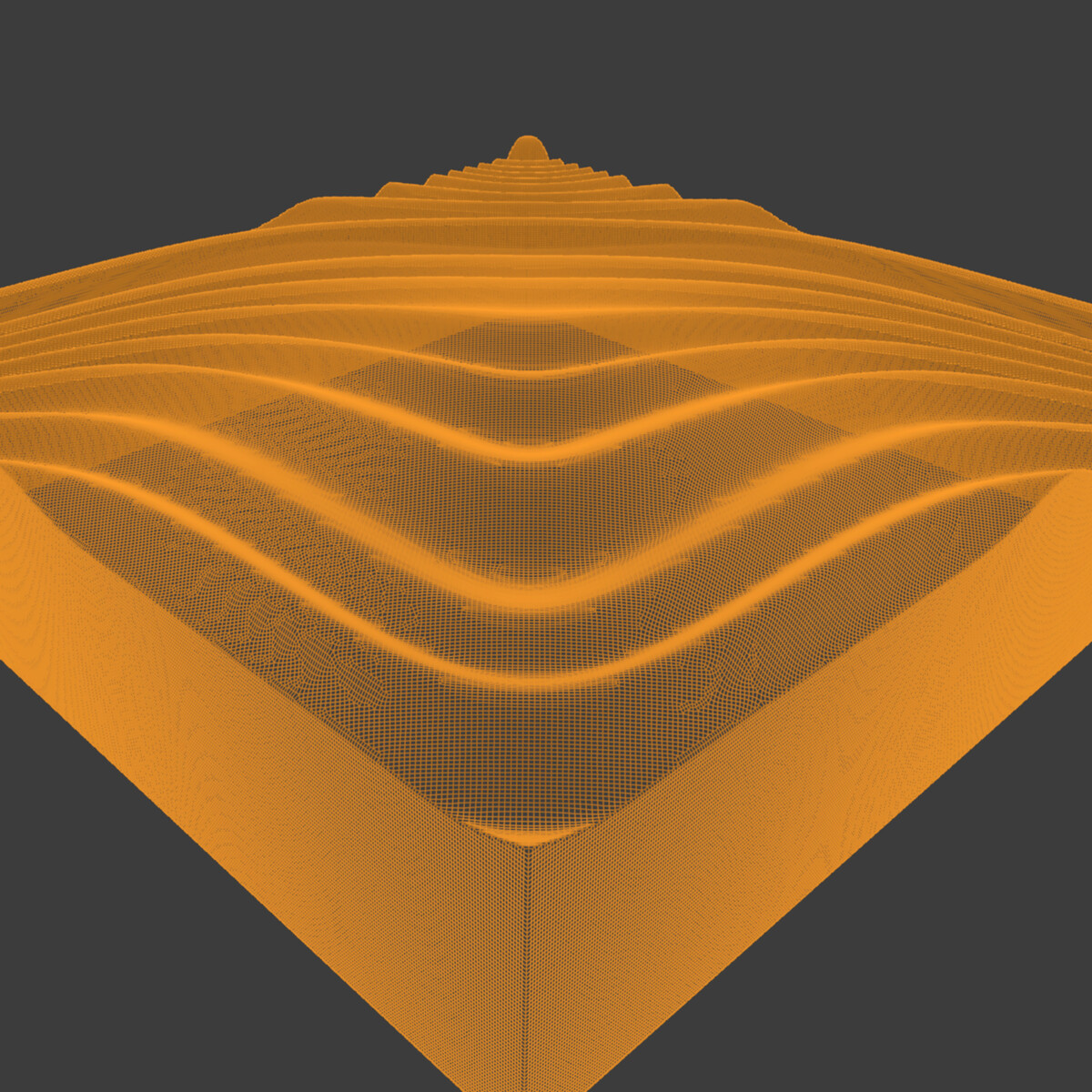

To create the biodegradable art piece, I used rice as a binding agent to hold the cardboard and paper together, forming a solid and sturdy structure.
To make the building blocks, I blended rice starch, paper, and cardboard and pressed the mix into 3D-printed molds. Once dried, the resulting pieces were solid, extremely strong, and lightweight (~85g). Although they were ’temporarily’ resistant to weather, they were able to dissolve in a bucket of water in a few seconds.
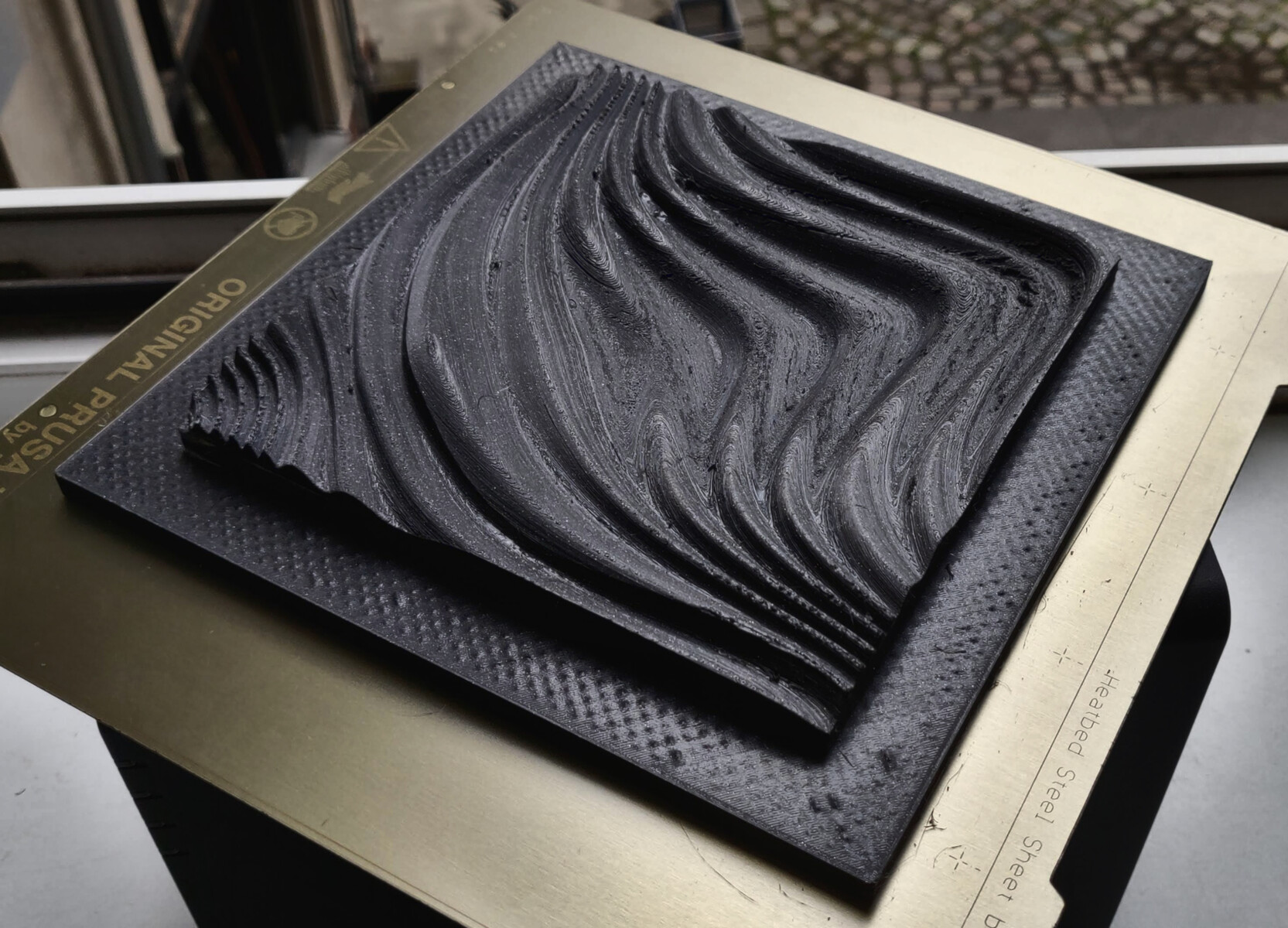
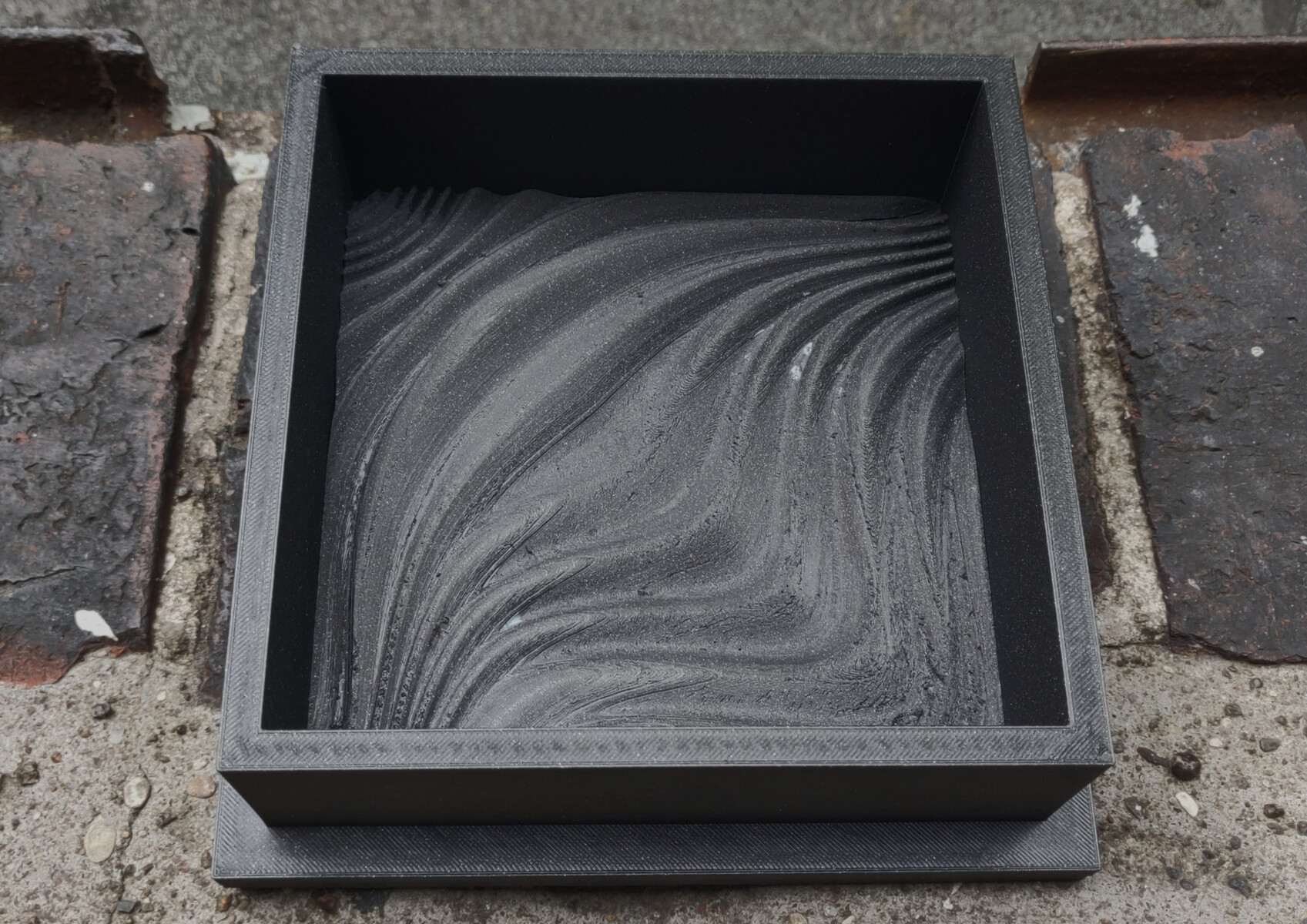
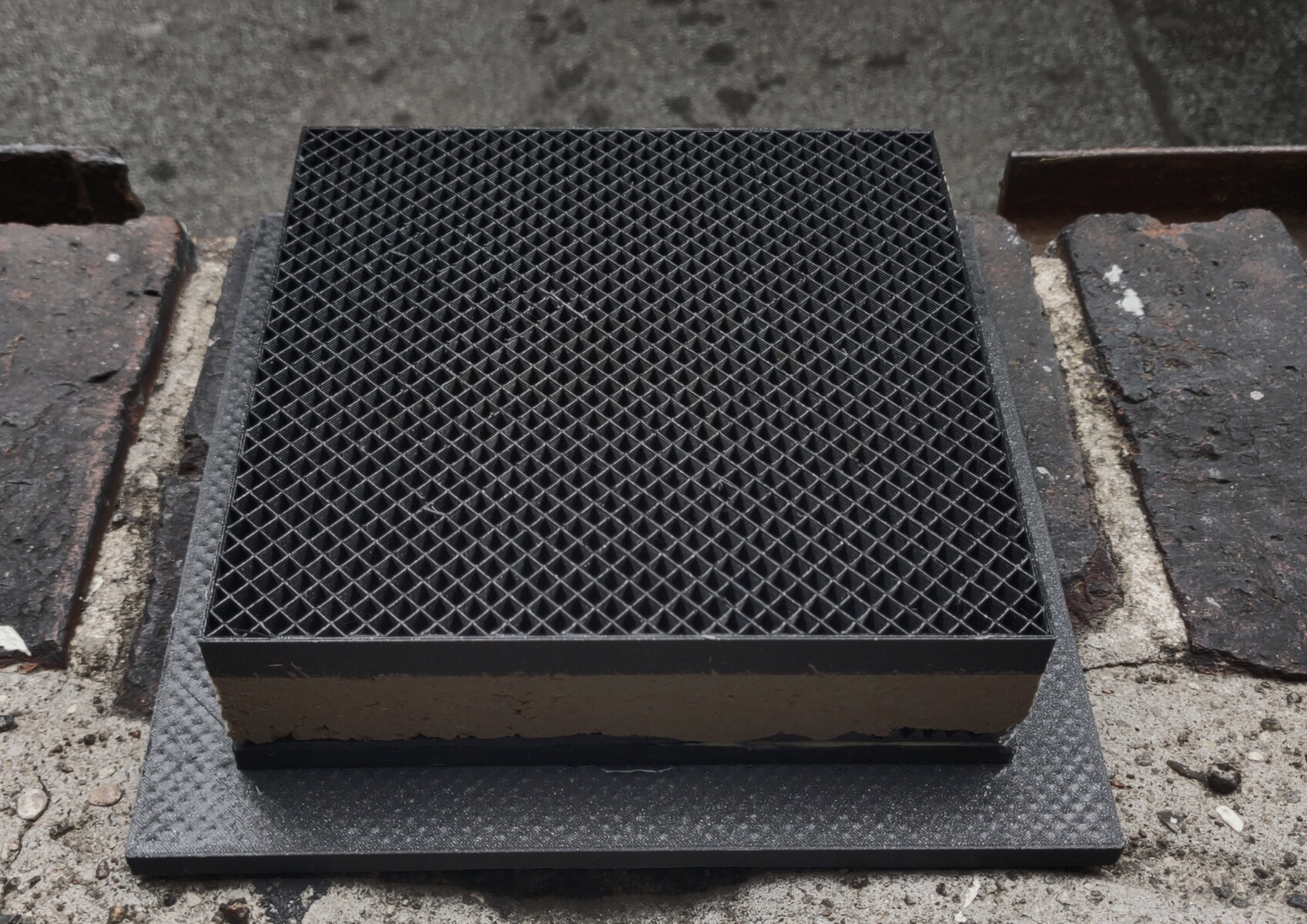
To join the blocks of material, I used over-hydrated rice paper. These rice sheets are sticky due to the starch content, which acts as glue to hold the pieces together. Once the rice paper dries, it hardens and becomes quite strong. However, after a few months of drying, the rice paper becomes somewhat brittle and may shatter if struck. Despite this, it is still able to hold the pieces together effectively.
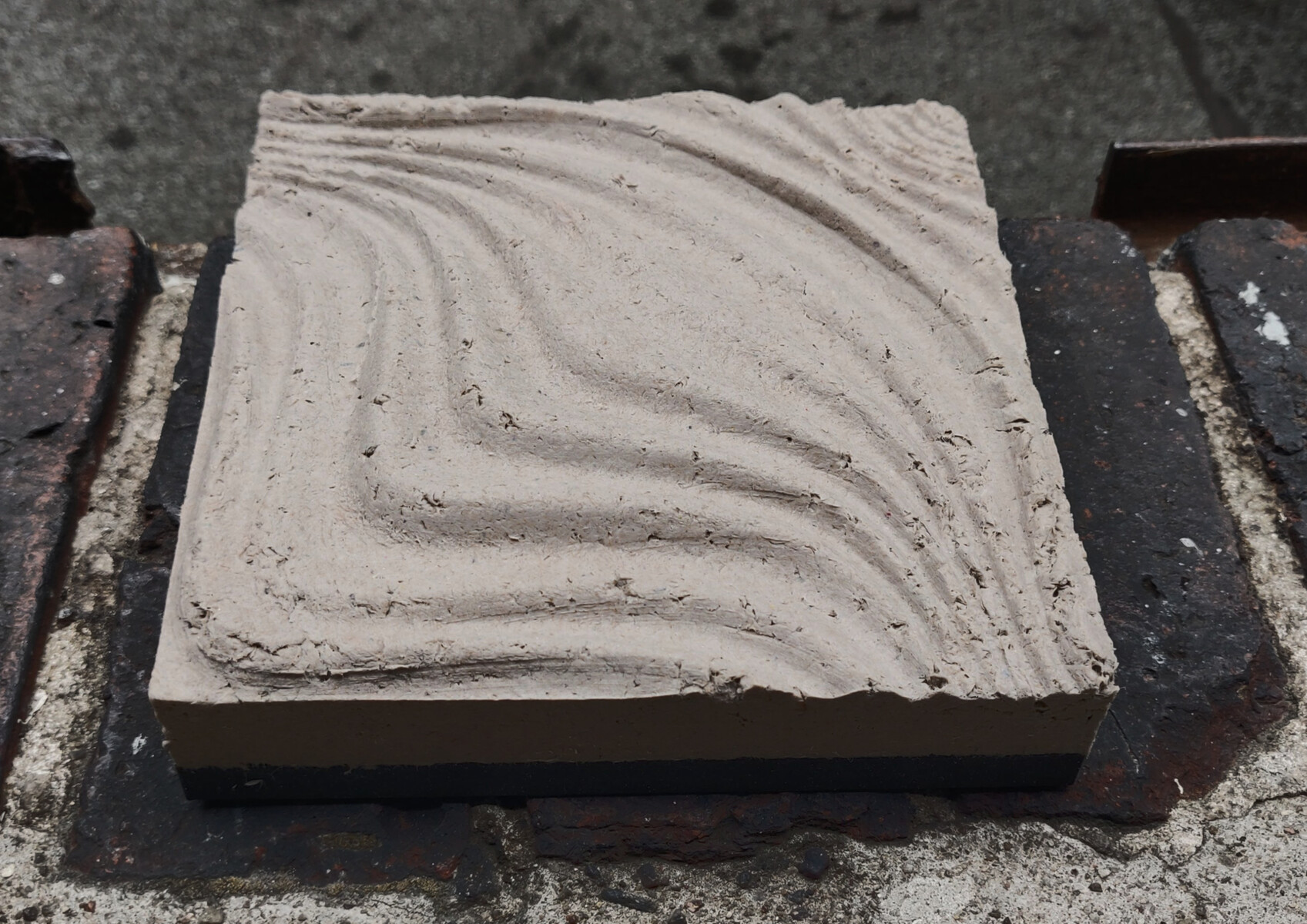
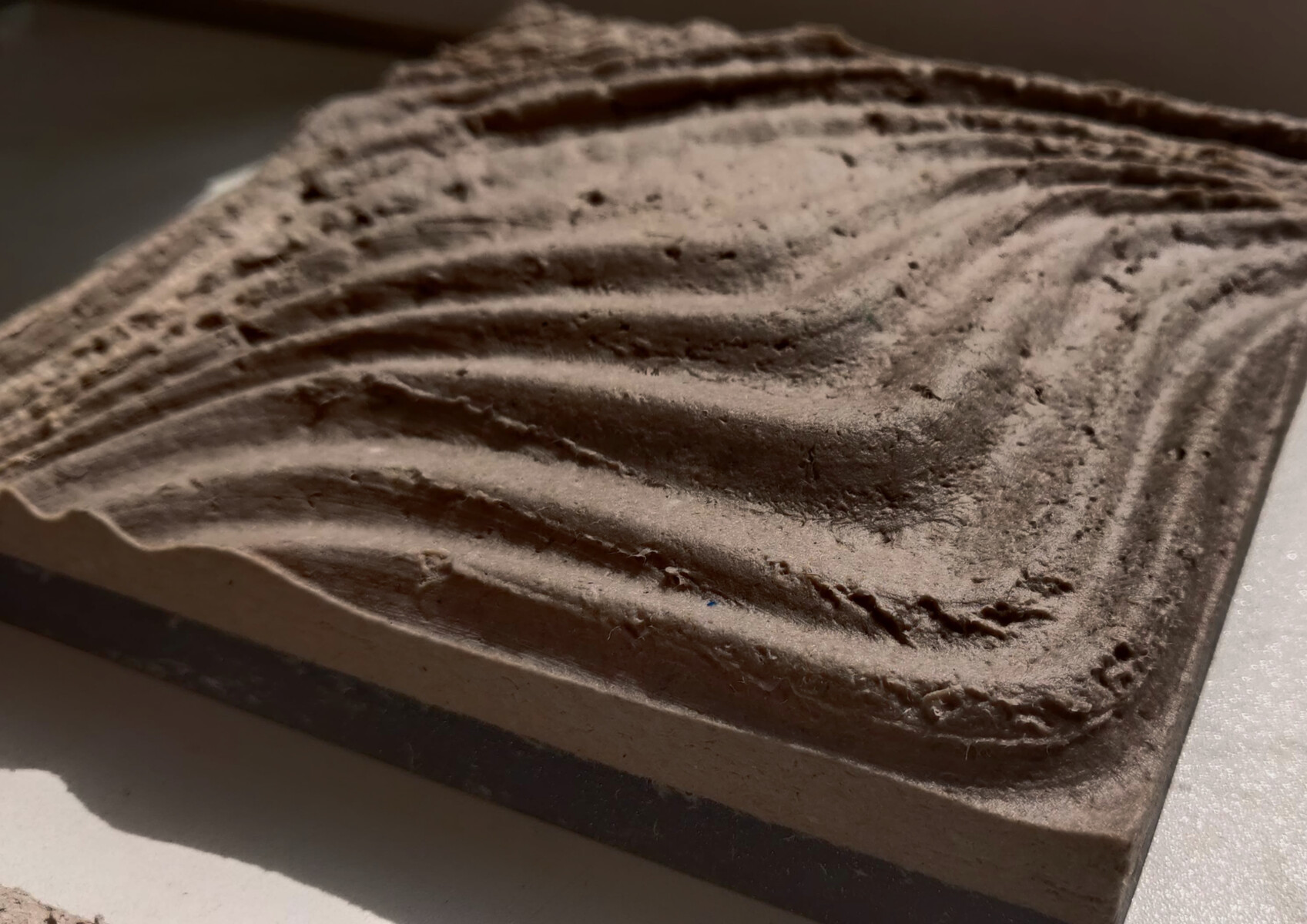

To test the robustness of this biodegradable art, I exposed the piece to the elements, placing it outdoors for a year to investigate how the weather and environment would affect the material and integrity of the piece.


Throughout the year, the piece was subjected to a range of weather conditions, including rain, wind, snow, and sunlight. Despite these challenges, the piece remained intact and retained its structural integrity. This suggests that biodegradable art pieces can be robust enough to be displayed, provided they are made with the right materials and techniques.

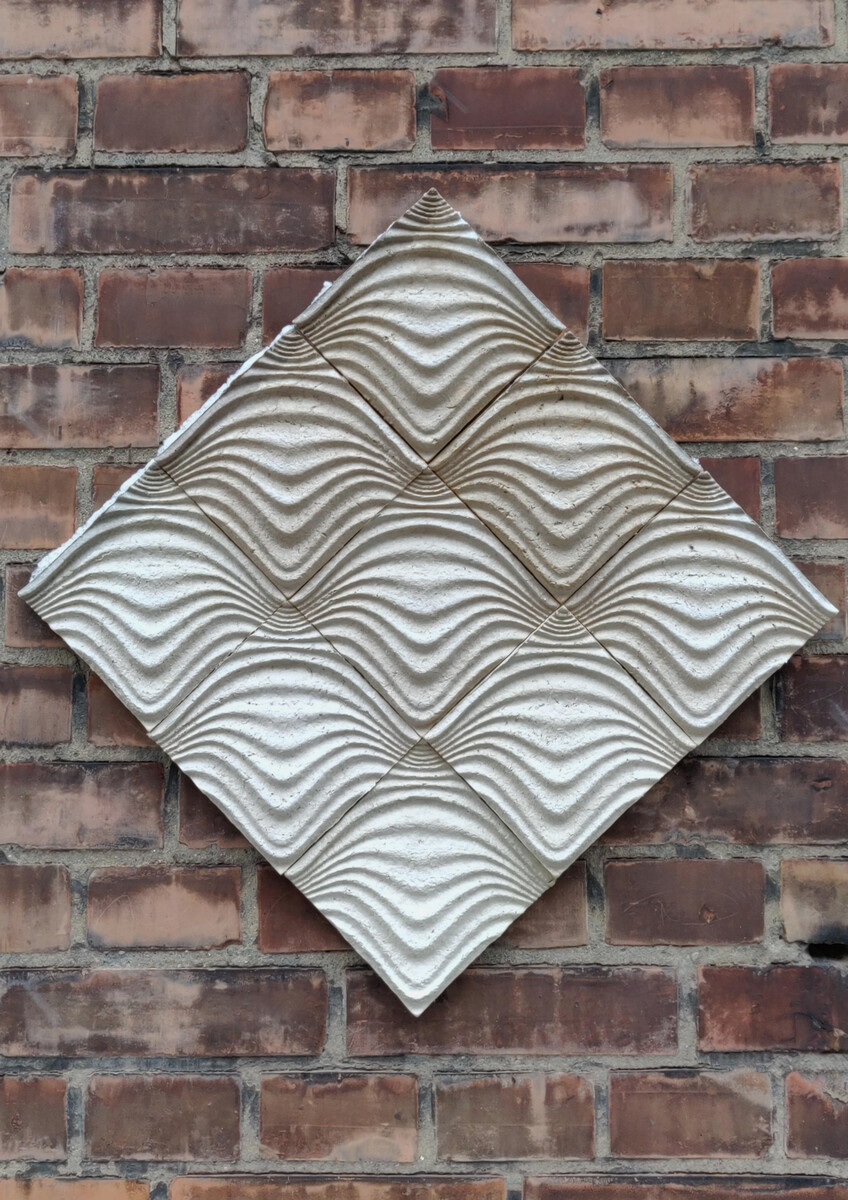
After this first year of exploration, I was very surprised by the material’s resistance. Although this is a positive outcome, my expectation was that the piece would dissolve in a few weeks, and that makes me wonder if the piece is exactly biodegradable.
So let’s then compare it with biodegradable plastics.
Both compostable plastics and biodegradable plastics are materials that break down into their organic constituents; however, composting of some compostable plastics requires strict control of environmental factors. – Wikipedia
Some biodegradable plastics are compostable (but not all), which means they degrade under controlled conditions, such as those occurring at compost (or anaerobic digestion) sites. – Let’s Do It Foundation
In this term, the material is rather compostable and it would actively degrade under specific conditions, including temperature, humidity, pH, carbon to nitrogen ratio, and the effect of moisture.
Phase #2
I find the idea of creating a work of art that, upon exhibition, transforms into fertile organic material and ultimately becomes a part of the natural environment to be particularly interesting. Where the artwork once stood, a forest now exists
In the second part of my research, I focused on using the material of the piece as fertile organic matter to not only accelerate degradation but also to add potential organic matter to the waste material.
To achieve this, I mixed legume seeds into the molds. The growth of the roots helps to break down the material and allows for better penetration of moisture, making it easier for bacteria and insects to access the material and facilitating degradation in an open environment without the need for a composting process. When the material is discarded, it will be loaded with organic matter, making it more useful.
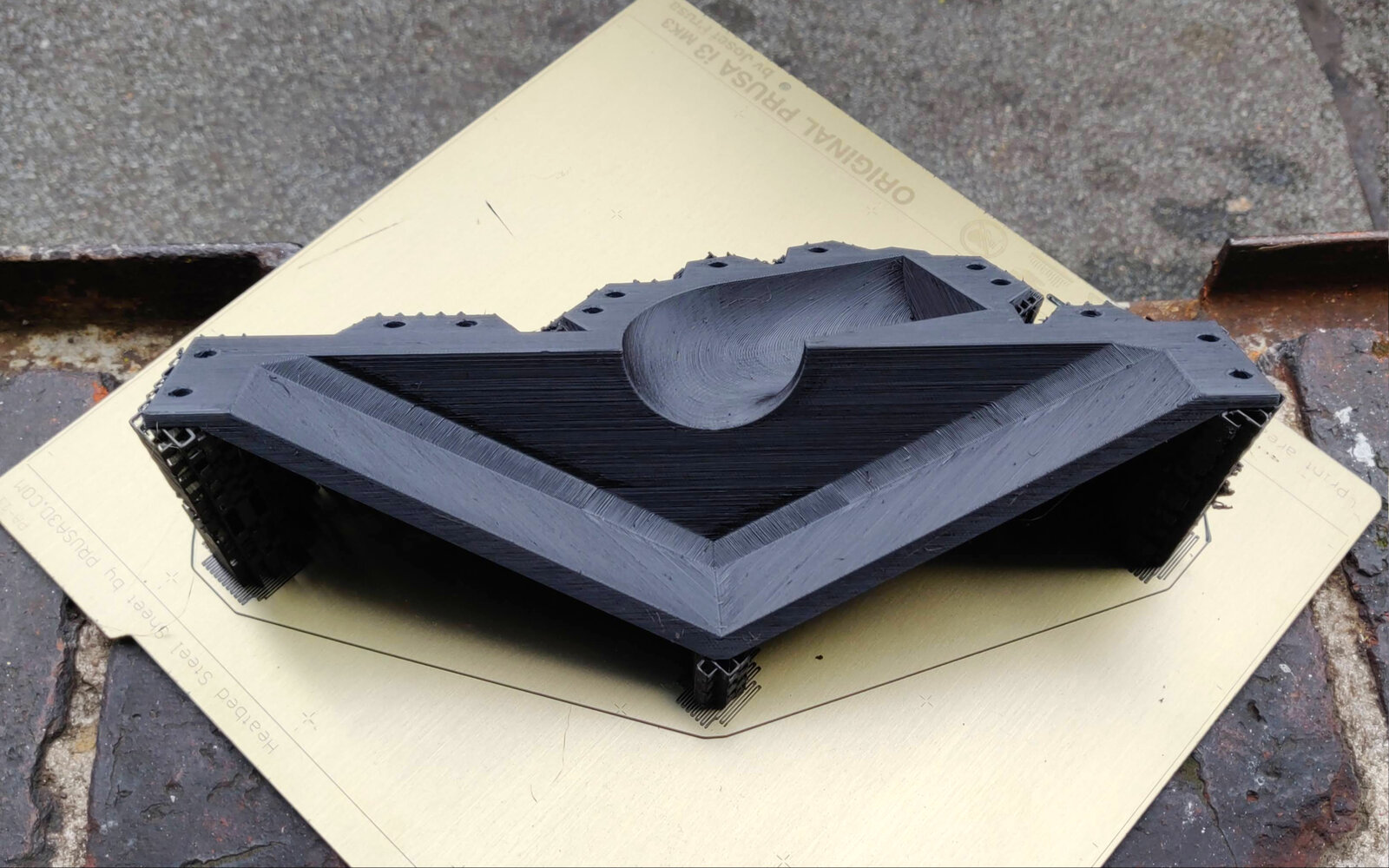

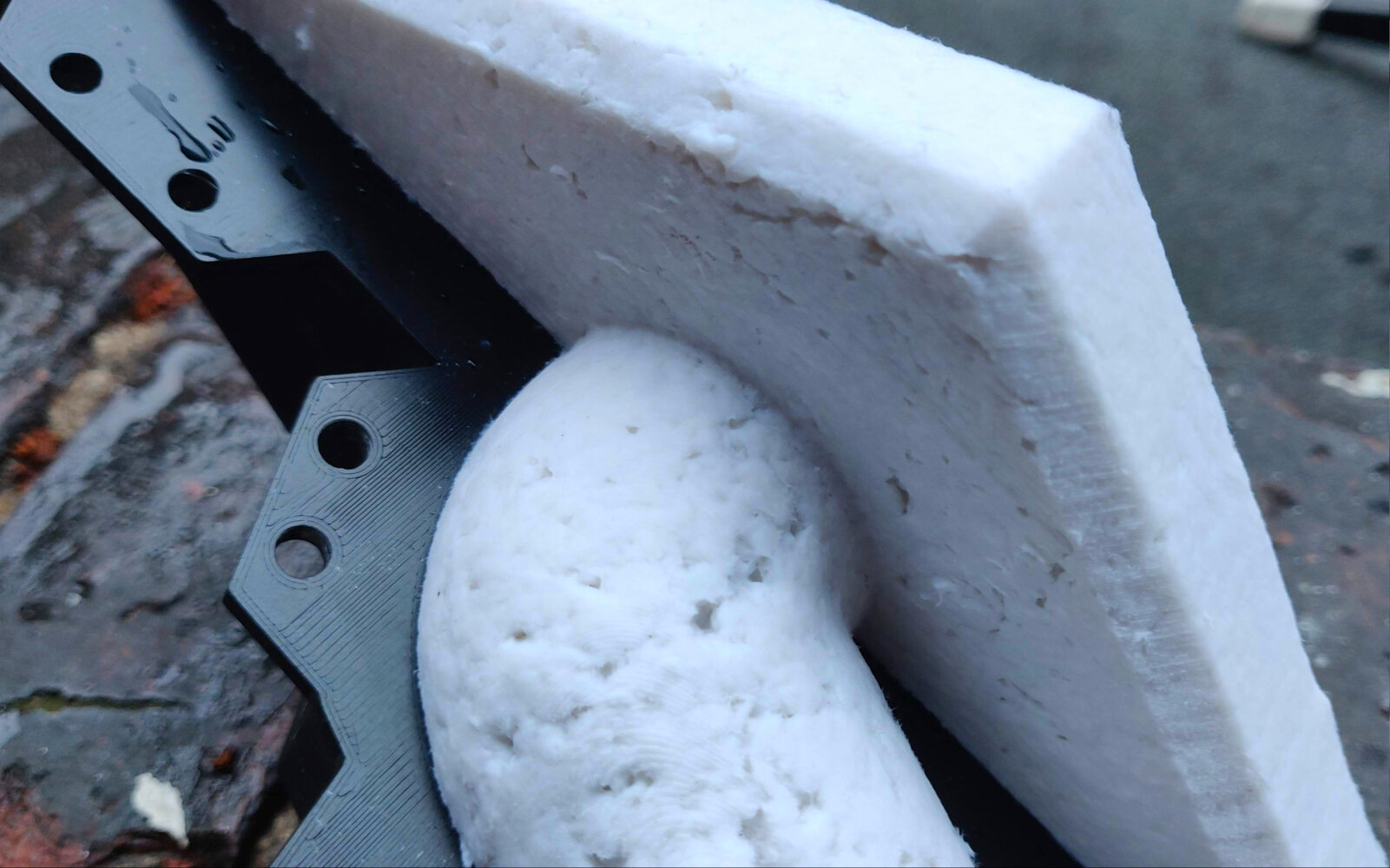
One of the desired outcomes is that the seeds will germinate and the growth of plants and leaves will be visible, breaking down the piece during the exhibition period.
Having in mind the self-degradation of the piece, the shapes for this version were designed to catch broken pieces and debris.
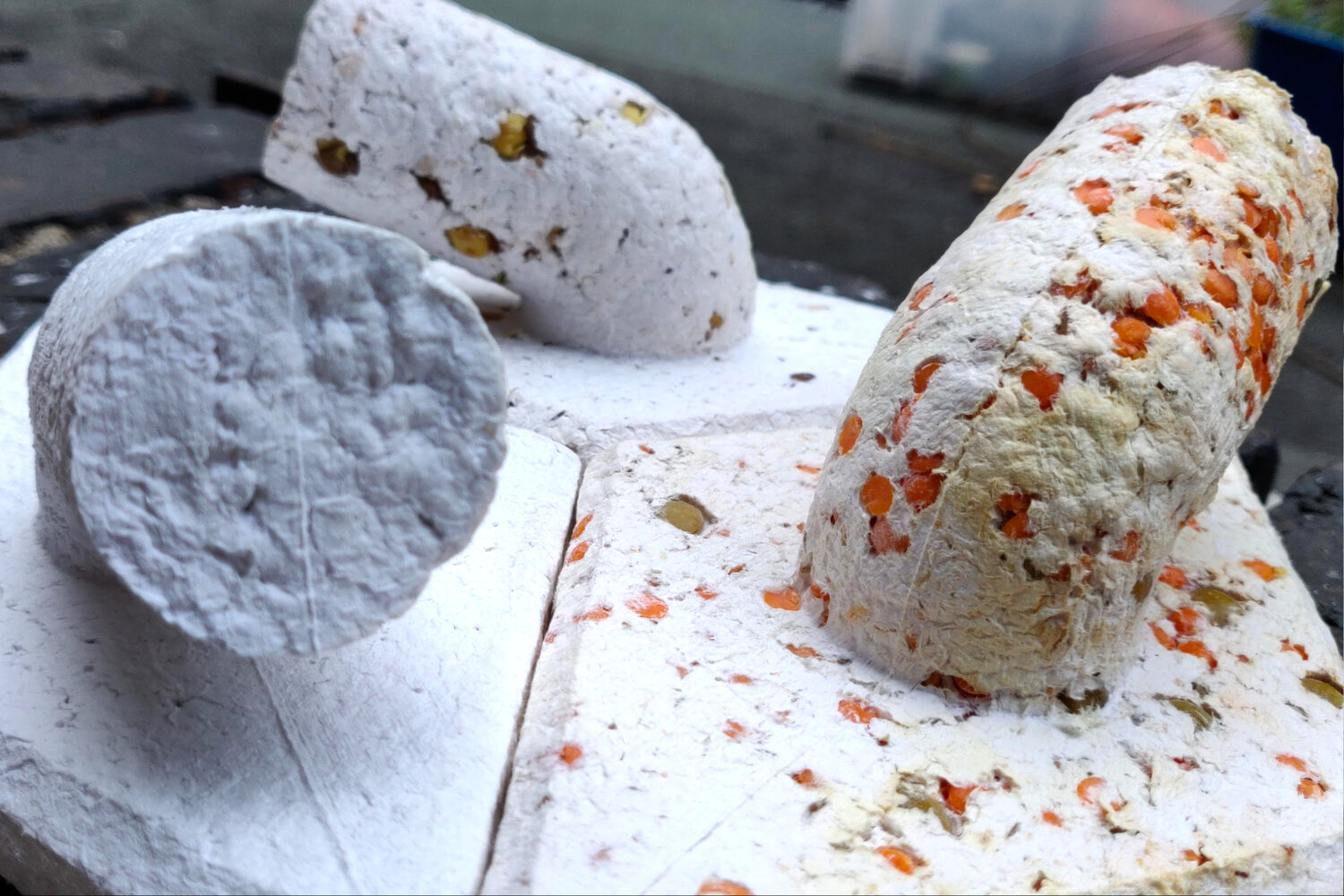

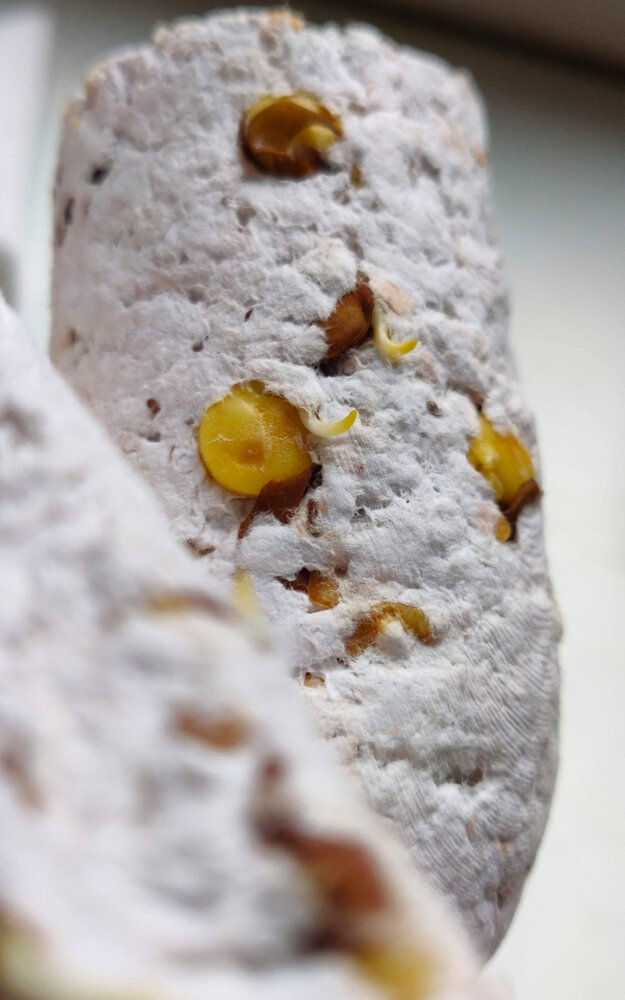
The use of legumes in this biodegradable sculpture is motivated by their rapid germination rate and ability to produce protein-rich sprouts. Lentils are a common source of protein and are widely cultivated for this purpose. When discarded, the material will quickly decompose into useful organic matter, increasing the value of the waste and potentially improving soil health.
Outcomes
Even if the research continues running, there are several findings that makes a positive outcome
The prototype was able to withstand a range of weather conditions for a year, including rain, wind, snow, and sunlight. This suggests that biodegradable art can be robust enough to be displayed, provided it is made with the right materials and techniques. It has the potential to be used in outdoor exhibitions and public spaces without fear of it disintegrating or falling apart.
The use of rice as a binding agent allows for the creation of strong and lightweight building blocks. The materials used in the art piece can be easily disposed of and do not contribute to environmental pollution.
The use of seeds in the molds has the potential to accelerate degradation and add potential biomass to the material. This means that the material will break down more quickly and can be used as fertilizing matter once it has decomposed. It means that the material can be reused in the environment, rather than being discarded as waste.
Biodegradable art has the potential to be both aesthetically pleasing and environmentally friendly. By using the right materials and techniques, it is possible to create durable, lightweight, and biodegradable art that can be used in outdoor exhibitions and public spaces without causing harm to the environment.
Art has the power to not only inspire and evoke emotion, but it can also challenge societal norms and ask important questions. This is especially true when it comes to the concept of creating art using recycled materials and reducing our carbon footprint.
There are many artists working in this field, proving that the value of art goes beyond the materials it is made from. By using recycled materials, these artists are not only showcasing their creativity and talent, but they are also making a statement about the impact our actions can have on the environment.
Not only do these artists create beautiful and thought-provoking pieces, but their work can also reach and influence other industries and circles. The art world has the power to inspire change and spark important conversations, and this is particularly evident in the work of artists who are using their platform to promote sustainability and environmental awareness.
In a world where our actions have a significant impact on the planet, it is important to consider the ways in which we can reduce our carbon footprint and reuse materials. The artists working in this field serve as a reminder of the power and potential of art to inspire change and make a positive difference in the world.
Olafur Eliasson is an Icelandic artist known for his large-scale installations that explore the relationship between humans and nature. Eliasson often uses natural materials such as ice, water, and plants in his work, as well as recycled materials like plastic bottles and paper.
Christo is an artist known for his large-scale, temporary installations that often involve wrapping or enclosing buildings or landscapes in fabric or other materials. Many of his works are made with recycled or sustainable materials, such as recycled plastic or biodegradable fabric.
Ai Weiwei is a Chinese artist who often uses recycled materials in his work, including discarded bicycles, doors, and windows. Weiwei’s art addresses social and political issues, and he often incorporates sustainable practices into his projects as a way of drawing attention to environmental concerns.
Nils Udo is a French artist who creates sculptures and installations using natural materials such as twigs, leaves, and branches. Udo’s work often explores the relationship between humans and nature, and he often incorporates sustainable practices into his projects, such as using biodegradable materials and planting new trees after his exhibitions.
Angela Haseltine Pozzi is an American artist who creates sculptures and installations using recycled materials such as plastic bottles and trash. Pozzi’s work addresses environmental issues, and she often incorporates sustainable practices into her projects, such as using biodegradable materials and collaborating with organizations to clean up trash from the oceans and beaches.